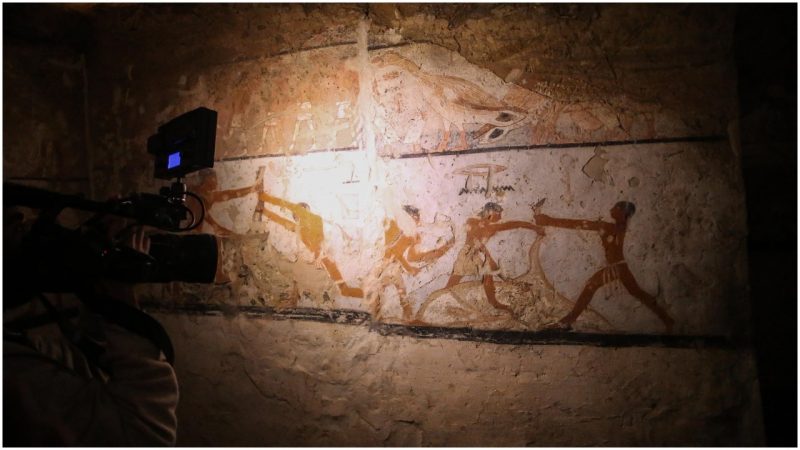
Despite all the discoveries that have been made about Ancient Egypt, archaeologists are confident that there’s more to be found, new riches sleeping under the vast dunes of the desert. They seem to be right, as a tomb was recently unearthed that belonged to an important ancient priestess, a precious discovery that provides insights into the life of an ancient Egyptian woman of high rank more than four millennia ago. The recent find happened close to the country’s renowned Pyramids of Giza and roughly 12 miles to the south of the capital of Cairo.
The newly uncovered tomb, as old as 4,400 years, includes rare decoration such as intriguing wall paintings. Some of them feature portrayals of what is believed to be the high priestess named Hetpet, Egypt’s Antiquities Ministry officials stated while announcing the discovery on February 3, 2018. One of the spokespersons, Secretary-General of the Supreme Council of Antiquities Mostafa Waziri, remarked that the site was found in “very good condition.”
“There are colored depictions of traditional scenes: animal grazing, fishing, bird-catching, offerings, sacrifice, soldiers, and fruit-gathering,” Waziri said of the paintings that adorn the tomb of the priestess.
Hetpet was a priestess to Hathor, the Ancient Egyptian deity of fertility, motherhood, dance, and music. In general, female priestesses were not common in that era, but worshiping Hathor was well known. Typically represented with a head of a cow, Hathor had a number of priestesses. Hetpet, as one of them, is considered to have been closely affiliated with the royal family of the Fifth Dynasty. Though a notable figure of antiquity, her mummy was never found.
The work on the site included removing roughly 10,000 cubic feet of earth to unearth the tomb, making it the first major discovery in the country for 2018. In a press conference that was held in Giza following the finding of the tomb, officials remarked that they expect more discoveries in the forthcoming period.
Archaeologists conclude that the tomb belongs to the period of the Fifth Dynasty due to the featured decoration as well as the style in which the tomb is built. The priestess herself is depicted standing in various scenes. In some, she is presented offerings by children. In others, she appears to look on hunting and fishing activities. Inscriptions of her name and titles have also been found at the site.
One of the most dazzling scenes of all includes one with a monkey, animals which were back then domesticated and helped their owners in activities such as collecting fruit. Among the paintings in Hetpet’s tomb, a monkey can be seen dancing in front of an orchestra, what some commentaries have described as a rare portrayal. In previously discovered scenes, the animal has been found dancing in front of a guitarist alone.
The latest archaeological mission, which is being carried out in the wider area of the western necropolis of Giza, commenced in the last quarter of 2017. However, the same area that contained Hetpet’s tomb has been already noted among archaeologists for hiding other treasures, included tombs dating to the Old Kingdom as well as more pieces of artifacts related to the figure of Hetpet. Unearthing some of them took place as early as the mid-19th century and early 20th century.
Near the excavated area, construction of a new facility that will serve as a museum has been commissioned too. While the new edifice is expected to feature Egypt’s numerous authentic artifacts, including belongings of the world-famous King Tutankhamun, the entire facility should be completed by 2022, the Telegraph reports.
The recent period has been marked by numerous significant discoveries for Egypt, spanning different periods and dynasties. In September 2017, Egyptian officials announced the discovery of a 3,500-year-old-tomb close to Luxor, one that belonged to a goldsmith and his spouse.
As tourism in Egypt has stagnated in the last couple of years due to safety concerns, Egyptian authorities are hopeful that with all the latest discoveries, including the tomb of the priestess, people will once more wish to visit the country.
